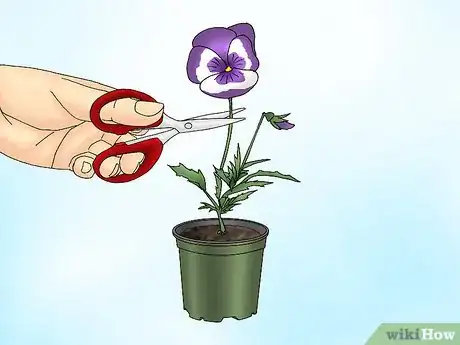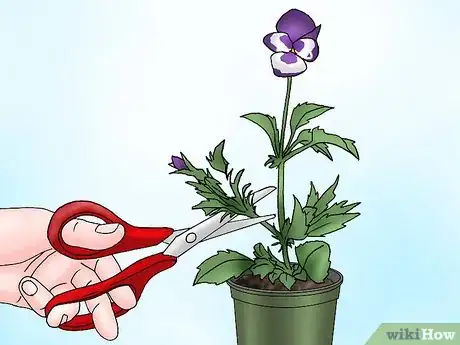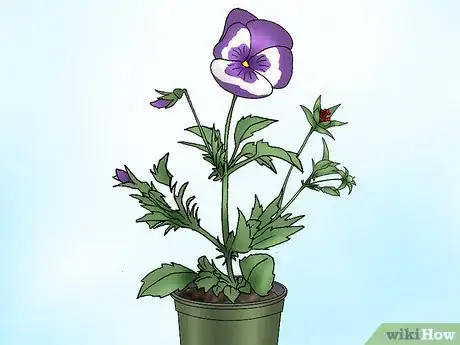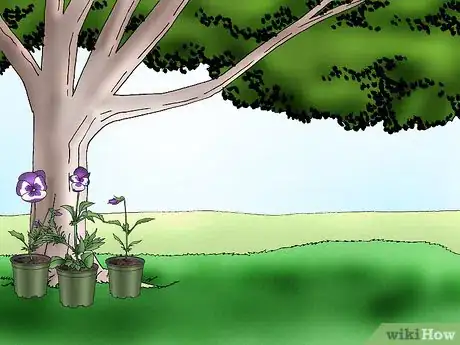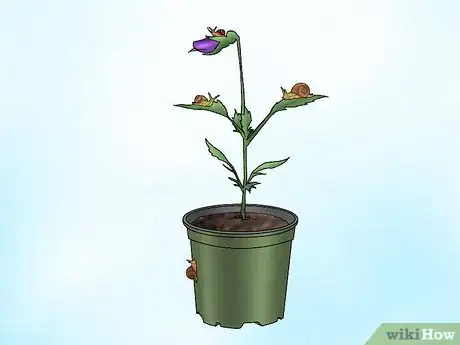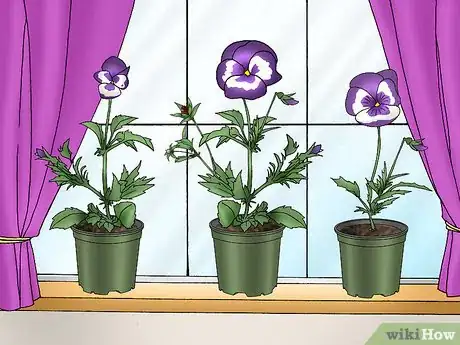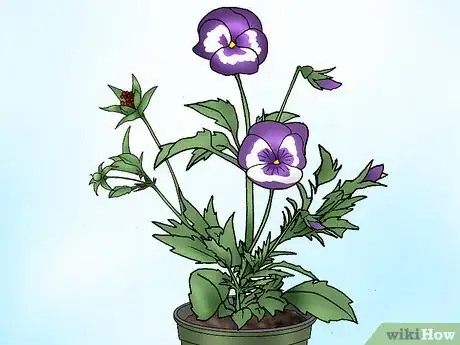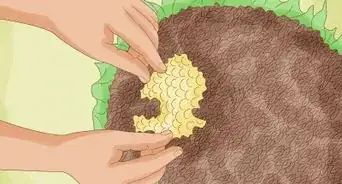This article was co-authored by Jon Rowland. Jon Rowland is a Plant Specialist and the Founder of the Green House Center blog. With over eight years of plant and garden experience, he specializes in greenhouse care, lawn and garden maintenance, and home appliance recommendations. Jon aims to share his knowledge so that others can live a more convenient, efficient, and environmentally friendly lifestyle.
There are 9 references cited in this article, which can be found at the bottom of the page.
wikiHow marks an article as reader-approved once it receives enough positive feedback. In this case, several readers have written to tell us that this article was helpful to them, earning it our reader-approved status.
This article has been viewed 94,999 times.
Pansies bloom in early spring and can add some lovely color to your garden after winter. Pansies are generally one of the first plants to come up in the spring, and will continue to bloom until the temperatures rise and cause the plant to become dormant. However, when temperatures drop in the fall, pansies can bloom again if you take a some time to prepare them in the spring.
Steps
Making Your Pansies Bloom Again
-
1Pinch seed pods to help your pansies bloom again. Pansy seeds will grow in long fall climates or they’ll remain dormant until the next spring in many areas. Therefore, in order to fool pansies into blooming again, you will need to remove the seed pods before the seeds fully form.
- This can be achieved by pinching the spent blooms from the plant, cutting back extra growth, and fertilizing for blooms rather than leaves.[1]
-
2Remove any dying blooms regularly. Check your pansy twice a week for any blooms that have died. Remove all dying blooms from the pansy plant to encourage the plant to put its energy towards new blooms and growth.[2]
- Remove any damaged blooms when you remove dead blooms.
- Be careful not to accidentally remove any new blooms.
Advertisement -
3Keep the soil moist and apply a phosphorous fertilizer. Water the plant to keep the soil around the pansy moist. Pansies enjoy soil that is damp.[3] Try to apply a phosphorus fertilizer but avoid applying nitrogen to the area unless the fertilizer is a slow release variety, as pansies generally can’t handle high levels of nitrogen.
- If the plant is allowed to dry out or receives too little nutrition it will stop producing blooms and need to be replanted.
-
4Cut away growth and leggy stems. Cut back growth and leggy stems from the plant because these areas will not produce new blooms. When these parts of the plant are allowed to grow unchecked, they can drain the energy of the plant, causing it to produce less blooms.[4]
-
5Check for seed pods that were not pinched back as blooms. If you find any existing seed pods, remove them right away.
- If your plant is an heirloom you may be able to save the adult pod and collect seeds to start more pansy plants indoors.
-
6Plant a new blooming pansy if your existing ones begins to die back. If the plant stops producing blooms and begins to die back, you will most likely need to replace the plant with a new blooming pansy in order to benefit from new fall color.[5]
- If this occurs frequently do not feel like you’ve failed; certain areas of the country simply are not suited for year round pansy growth.
- If you can’t find new pansies at your greenhouse to plant in the fall, remember that pansies are simple to start from seed indoors.
- Plan ahead for next year and start the seedlings indoors four to six weeks before fall. After the temperatures get warmed, plant the new seedlings outdoors.
Placing Your Pansy in a Bloom-Encouraging Location
-
1Grow your pansies in the correct conditions. To start, you need to consider the placement of your pansies. They should be in a cool, moist, protected area of your garden.[6]
- Consider placing them under a tree that will provide shade for the pansies.
-
2Keep critters in mind when selecting a location for your pansies. While the pansy plant is very hardy, its flowers will be eaten by critters, bugs, and anything else that might come along so try to plant them in a protected area.[7]
-
3Protect your pansy from the elements. Pansy plants will look rough and not well cared for if they are placed in an area with large amounts of wind and rain. Try to reserve a safe spot in your garden for them that is shielded against the wind.
-
4Move your potted pansy out of direct sunlight. If placed in a container, be sure your plant does not receive sun during the hottest hours of the day.
- Move the container during the summer to a cooler area to encourage blooms year round.
-
5Understand why pansies tend to stop blooming. The reason pansies stop blooming is in the design of the plant. Pansies bloom early in the spring, produce seeds, then die back in the summer.[8]
Expert Q&A
-
QuestionWhen should you plant pansies?
 Jon RowlandJon Rowland is a Plant Specialist and the Founder of the Green House Center blog. With over eight years of plant and garden experience, he specializes in greenhouse care, lawn and garden maintenance, and home appliance recommendations. Jon aims to share his knowledge so that others can live a more convenient, efficient, and environmentally friendly lifestyle.
Jon RowlandJon Rowland is a Plant Specialist and the Founder of the Green House Center blog. With over eight years of plant and garden experience, he specializes in greenhouse care, lawn and garden maintenance, and home appliance recommendations. Jon aims to share his knowledge so that others can live a more convenient, efficient, and environmentally friendly lifestyle.
Plant Specialist You should plant pansies in spring or autumn. It’s recommended to buy an established pansy rather than to start with the seed for the inexperienced. If you want to grow pansies from seeds, it will be helpful to start seeding 8-10 weeks in advance of spring or autumn.
You should plant pansies in spring or autumn. It’s recommended to buy an established pansy rather than to start with the seed for the inexperienced. If you want to grow pansies from seeds, it will be helpful to start seeding 8-10 weeks in advance of spring or autumn. -
QuestionPansies are still blooming but flowers are very small, why?
 NinoxTop AnswererA possible cause is the lack of nutrients. During the blooming period, you can add fertilizer every 2 weeks.
NinoxTop AnswererA possible cause is the lack of nutrients. During the blooming period, you can add fertilizer every 2 weeks.
References
- ↑ https://www.uaex.edu/counties/white/news/horticulture/201810_All_About_Pansies.aspx
- ↑ https://www.youtube.com/watch?v=UMc5w5i9M3U
- ↑ https://newswire.caes.uga.edu/story.html?storyid=119&story=Picture-Perfect-Pansies
- ↑ https://www.petittigardencenter.com/planting_guide/SpringPansyViolaCare.pdf
- ↑ https://www.almanac.com/plant/pansies
- ↑ https://www.goodhousekeeping.com/home/gardening/a20706070/pansy-flower/
- ↑ https://hgic.clemson.edu/factsheet/pansy-diseases-insect-pests/
- ↑ https://living.thebump.com/pansies-come-back-year-die-off-summer-heat-11016.html
- https://www.uaex.edu/yard-garden/home-landscape/docs/pansies.pdf
About This Article
To make pansies bloom again, pinch the seed pods off of the plant, which will fool the pansies into thinking it’s time to bloom again. Cut back any excess growth and clip off faded or dead flowers that are still holding on or wilting. You should also fertilize your pansies once every 2-3 weeks. To speed up the flowering process, use a fertilizer that’s high in phosphorus or bone meal, or a 5-10-5 fertilizer. Water your pansies whenever the soil starts to dry out. If they're indoors, keep them in a cool area that gets a lot of sunlight to promote growth. When your pansies do bloom again, pinch off any new seed pods so the plant keeps growing. If your pansies still aren’t blooming, even in the fall and spring, they may be at the end of their life cycle. Many pansies stop blooming after a few seasons. For more advice on making pansies bloom again, like picking the best location for planting, read on.

